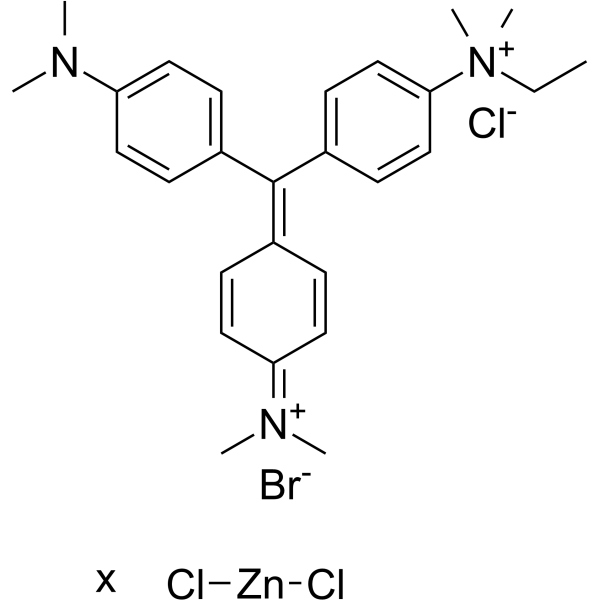Methyl green

Methyl green structure
|
Common Name | Methyl green | ||
|---|---|---|---|---|
| CAS Number | 7114-03-6 | Molecular Weight | 653.259 | |
| Density | N/A | Boiling Point | N/A | |
| Molecular Formula | C27H35BrCl3N3Zn | Melting Point | >300 °C(lit.) | |
| MSDS | Chinese USA | Flash Point | N/A | |
| Symbol |

GHS07 |
Signal Word | Warning | |
|
Developmental Expression and Glucocorticoid Control of the Leptin Receptor in Fetal Ovine Lung.
PLoS ONE 10 , e0136115, (2015) The effects of endogenous and synthetic glucocorticoids on fetal lung maturation are well-established, although the role of leptin in lung development before birth is unclear. This study examined mRNA and protein levels of the signalling long-form leptin rece... |
|
|
Design, Preparation, and Characterization of Zn and Cu Metallopeptides Based On Tetradentate Aminopyridine Ligands Showing Enhanced DNA Cleavage Activity.
Inorg. Chem. 54 , 10542-58, (2015) The conjugation of redox-active complexes that can function as chemical nucleases to cationic tetrapeptides is pursued in this work in order to explore the expected synergistic effect between these two elements in DNA oxidative cleavage. Coordination complexe... |
|
|
Luminescent europium and terbium complexes of dipyridoquinoxaline and dipyridophenazine ligands as photosensitizing antennae: structures and biological perspectives.
Dalton Trans. 44 , 19844-55, (2015) The europium(III) and terbium(III) complexes, namely [Eu(dpq)(DMF)2(NO3)3] (1), [Eu(dppz)2(NO3)3] (2), [Tb(dpq)(DMF)2Cl3] (3), and [Tb(dppz)(DMF)2Cl3] (4), where dipyrido[3,2-d:2',3'-f]quinoxaline (dpq in 1 and 3), dipyrido[3,2-a:2',3'-c]phenazine (dppz in 2 ... |
|
|
Modulation of Fas-Fas Ligand Interaction Rehabilitates Hypoxia-Induced Apoptosis of Mesenchymal Stem Cells in Ischemic Myocardium Niche.
Cell. Transplant. 24 , 1329-41, (2015) Mesenchymal stem cells (MSCs) have the potential to repair and regenerate ischemic heart tissue; however, the poor viability of transplanted MSCs in the ischemic region is a major obstacle to their therapeutic use. This cell death is caused by Fas and Fas lig... |
|
|
Bone status of acetylcholinesterase-knockout mice.
Int. Immunopharmacol. 29 , 222-30, (2015) Acetylcholinesterase (AChE) hydrolyzes acetylcholine (ACh) to acetate and choline and thereby terminates nerve impulse transmission. ACh is also expressed in bone tissue and enhances here proliferation and differentiation of osteoblasts, which makes it intere... |
|
|
TAF4b promotes mouse primordial follicle assembly and oocyte survival.
Dev. Biol. 392(1) , 42-51, (2014) Primary ovarian insufficiency (POI) affects 1% of women under the age of 40 and is associated with premature ovarian follicle depletion. TAF4b deficiency in adult female mouse models results in hallmarks of POI including stereotyped gonadotropin alterations i... |
|
|
Graphene oxide nanosheets at the water-organic solvent interface: utilization in one-pot adsorption and reactive extraction of dye molecules.
ChemPhysChem 15(18) , 4019-25, (2014) Graphene oxide (GO) is amphiphilic in nature, due to its structure, which consists of hydrophilic oxygen-containing functional groups and a hydrophobic basal plane of polyaromatic benzene rings. Due to this amphiphilicity, GO can create stable bubbles at wate... |
|
|
Periostin induces fibroblast proliferation and myofibroblast persistence in hypertrophic scarring.
Exp. Dermatol. 24(2) , 120-6, (2015) Hypertrophic scarring is characterized by the excessive development and persistence of myofibroblasts. These cells contract the surrounding extracellular matrix resulting in the increased tissue density characteristic of scar tissue. Periostin is a matricellu... |
|
|
Investigation into hippocampal nerve cell damage through the mineralocorticoid receptor in mice.
Mol. Med. Report. 12 , 7211-20, (2015) Stress‑associated neuropsychiatric disease is associated with glucocorticoid levels; however, the behavior of mineralocorticoid receptors (MR) under conditions of stress remain to be elucidated. Steroid receptors in the brain are classified into glucocorticoi... |
|
|
Zinc deficiency mediates alcohol-induced apoptotic cell death in the liver of rats through activating ER and mitochondrial cell death pathways.
Am. J. Physiol. Gastrointest. Liver Physiol. 308 , G757-66, (2015) Hepatic zinc deficiency has been well documented in alcoholic patients, but the mechanisms by which zinc deficiency mediates cell death have not been well defined. The objectives of this study were to determine whether alcohol perturbs subcellular zinc homeos... |